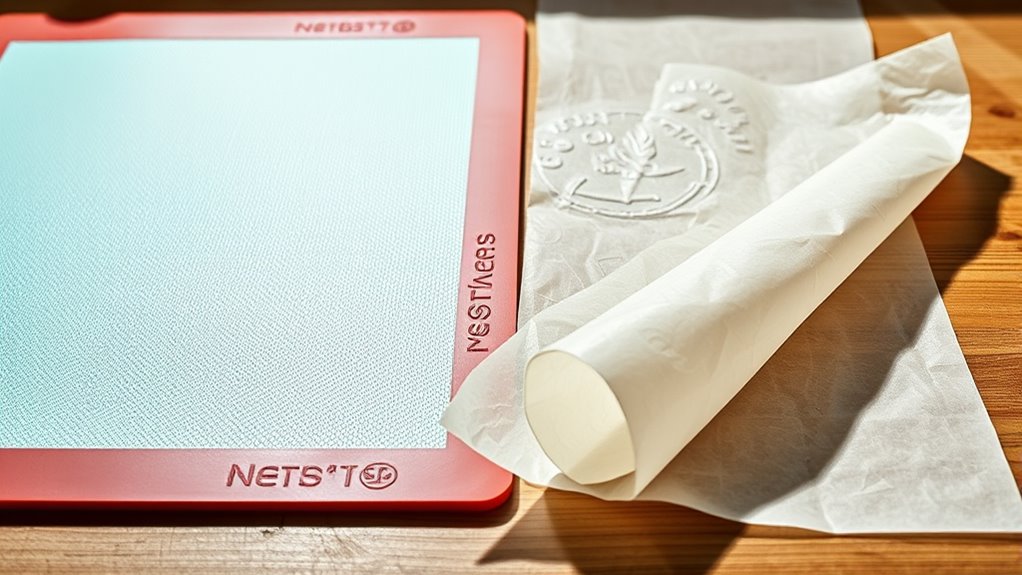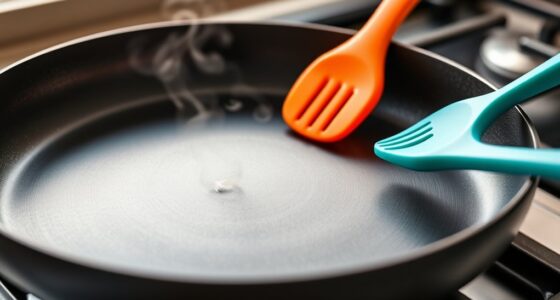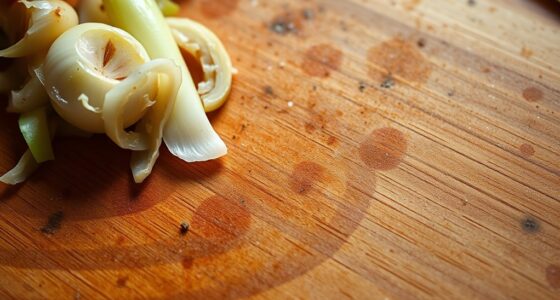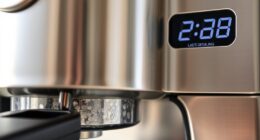Silicone mats are reusable, durable, and offer reliable non-stick performance, making them ideal for frequent baking. They withstand higher temperatures and are easy to clean, reducing waste and ongoing costs. Parchment paper is convenient for one-time tasks and disposable, but it can stick and isn’t as heat resistant. If you want a long-lasting solution or bake often, silicone mats might be best. Keep exploring to discover which option suits your baking style perfectly.
Key Takeaways
- Silicone mats are reusable and more durable, while parchment paper is single-use and disposable.
- Silicone mats withstand higher temperatures (up to 450°F) compared to parchment paper (around 420°F).
- Silicone mats offer reliable non-stick performance over many uses, whereas parchment may stick with sticky recipes.
- Silicone mats are easy to clean and environmentally friendly; parchment paper creates waste after each use.
- Parchment paper is convenient for quick, one-time baking, while silicone mats are ideal for frequent baking sessions.
When it comes to lining your baking sheets, silicone mats and parchment paper are two popular options, each offering distinct benefits. If you’re focused on non-stick properties, silicone mats excel because they are inherently non-stick, allowing baked goods to slide off easily without any additional greasing. Parchment paper also provides a non-stick surface, especially when coated with silicone, but traditional parchment can sometimes stick slightly, especially with sticky or sugary recipes. Both options help prevent baked items from sticking to the sheet, but silicone mats tend to be more reliable in this regard over repeated use.
Heat resistance is another critical factor to ponder. Silicone mats are highly heat resistant, typically enduring temperatures up to 450°F (232°C) or higher, making them suitable for most baking needs. They can be used repeatedly without degrading, which makes them a durable choice for frequent baking. Parchment paper, on the other hand, is also heat resistant but usually up to about 420°F (215°C). Beyond that, it can char or even catch fire, so you need to be mindful of oven temperature settings. When baking at high temperatures, silicone mats give you a wider safety margin, reducing the risk of smoke or fire hazards. Additionally, silicone mats often feature non-porous surfaces, which prevent the transfer of flavors and odors, maintaining the purity of your baked goods over time.
Silicone mats withstand higher temperatures, offering greater safety and durability for high-heat baking.
Durability is another aspect where silicone mats shine. They are reusable and can last for hundreds of baking sessions if cared for properly. Just wash them with warm soapy water, and they’re ready to go again. Parchment paper is single-use; once used, it’s discarded, which can add up in waste and cost over time. If you’re baking large quantities or doing frequent baking, silicone mats might be more economical in the long run.
Cleaning is easier with silicone mats. They are non-porous and dishwasher safe, so cleaning is quick and straightforward. Parchment paper, being disposable, doesn’t require cleaning, but if you do have a spill or residue, you’ll need to wipe or wash the baking sheet itself afterward. Silicone mats also provide a smooth surface that doesn’t absorb odors or flavors, maintaining the integrity of your baked goods over time.
Ultimately, your choice depends on your baking habits. Silicone mats offer superior heat resistance, durability, and non-stick properties for repeated use, making them an excellent investment. Parchment paper offers convenience and ease for one-time baking tasks, especially when you prefer a disposable option. Both have their place in your kitchen, but understanding these differences helps you make an informed decision tailored to your baking style.
Frequently Asked Questions
Are Silicone Mats Safe for High-Temperature Baking?
Yes, silicone mats are safe for high-temperature baking because of their durability. Most silicone mats can withstand temperatures up to 450°F (232°C), making them suitable for many baking needs. Unlike parchment paper, which is disposable, silicone mats are reusable and eco-friendly, offering consistent non-stick performance. Just verify you check the manufacturer’s temperature ratings to avoid any potential damage or safety issues during baking.
Can Parchment Paper Be Reused Multiple Times?
Parchment paper isn’t built for endless reuse; it’s like a fragile castle that crumbles after a few uses. Reusability concerns mean you should expect limited reuses—maybe 2-3 times—before it needs replacing. When it comes to cost comparison, parchment paper can add up quickly since you keep tossing it out, while silicone mats are more economical long-term because they’re durable and washable. So, if saving money is your goal, silicone mats are the smarter choice.
Do Silicone Mats Prevent Sticking Better Than Parchment Paper?
Silicone mats generally prevent sticking better than parchment paper, offering superior non-stick performance. They make baking easier because you don’t need additional sprays or oils, enhancing ease of use. Plus, silicone mats are reusable and durable, saving money over time. With their reliable non-stick surface, you can bake cookies, pastries, or roast vegetables without worrying about food sticking, making them a convenient and eco-friendly choice for your kitchen.
Are Silicone Mats Environmentally Friendly Compared to Parchment Paper?
Sure, silicone mats are the eco-heroes of the kitchen, right? Not quite. They’re reusable and boast better recyclability, but some might contain chemicals that raise safety questions. Parchment paper, on the other hand, is often biodegradable but single-use, making it less eco-friendly overall. So, if you’re chasing chemical safety and recyclability, silicone mats win. Just remember, they aren’t perfectly green, and your choices matter!
How Do Silicone Mats Affect Baked Goods’ Texture?
Silicone mats enhance your baked goods’ texture by promoting even heat distribution, which helps preserve moisture and prevents sticking. They prevent baked items from drying out, ensuring a softer, more consistent texture. Unlike parchment paper, silicone mats don’t absorb moisture, so your treats stay moist and tender. Overall, using silicone mats can improve texture preservation, making your baked goods come out with a desirable moisture level and a professional finish.
Conclusion
Choosing between silicone mats and parchment paper is like picking between a trusty companion and a fleeting guest. Silicone mats offer a reusable, eco-friendly surface that’s like having a reliable friend by your side, while parchment paper provides convenience and simplicity. Consider your baking needs and environment—whichever you choose, you’ll find a partner that helps your kitchen adventures run smoothly, turning each bake into a masterpiece. Happy baking!









